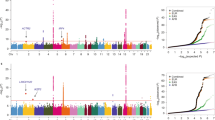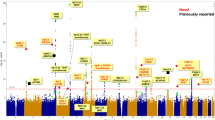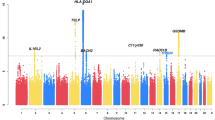Abstract
Lung cancer is the most common cause of cancer death worldwide, with over one million cases annually1. To identify genetic factors that modify disease risk, we conducted a genome-wide association study by analysing 317,139 single-nucleotide polymorphisms in 1,989 lung cancer cases and 2,625 controls from six central European countries. We identified a locus in chromosome region 15q25 that was strongly associated with lung cancer (P = 9 × 10-10). This locus was replicated in five separate lung cancer studies comprising an additional 2,513 lung cancer cases and 4,752 controls (P = 5 × 10-20 overall), and it was found to account for 14% (attributable risk) of lung cancer cases. Statistically similar risks were observed irrespective of smoking status or propensity to smoke tobacco. The association region contains several genes, including three that encode nicotinic acetylcholine receptor subunits (CHRNA5, CHRNA3 and CHRNB4). Such subunits are expressed in neurons and other tissues, in particular alveolar epithelial cells, pulmonary neuroendocrine cells and lung cancer cell lines2,3, and they bind to N′-nitrosonornicotine and potential lung carcinogens4. A non-synonymous variant of CHRNA5 that induces an amino acid substitution (D398N) at a highly conserved site in the second intracellular loop of the protein is among the markers with the strongest disease associations. Our results provide compelling evidence of a locus at 15q25 predisposing to lung cancer, and reinforce interest in nicotinic acetylcholine receptors as potential disease candidates and chemopreventative targets5.
This is a preview of subscription content, access via your institution
Access options
Subscribe to this journal
Receive 51 print issues and online access
$199.00 per year
only $3.90 per issue
Buy this article
- Purchase on Springer Link
- Instant access to full article PDF
Prices may be subject to local taxes which are calculated during checkout


Similar content being viewed by others
References
Ferlay, J., Bray, F., Pisani, P. & Parkin, M. GLOBOCAN 2002. IARC CancerBase No 5, version 2.0 (IARC, Lyon, 2004)
Minna, J. D. Nicotine exposure and bronchial epithelial cell nicotinic acetylcholine receptor expression in the pathogenesis of lung cancer. J. Clin. Invest. 111, 31–33 (2003)
Wang, Y. et al. Human bronchial epithelial and endothelial cells express α7 nicotinic acetylcholine receptors. Mol. Pharmacol. 60, 1201–1209 (2001)
Schuller, H. M. Nitrosamines as nicotinic receptor ligands. Life Sci. 80, 2274–2280 (2007)
Russo, P., Catassi, A., Cesario, A. & Servent, D. Development of novel therapeutic strategies for lung cancer: targeting the cholinergic system. Curr. Med. Chem. 13, 3493–3512 (2006)
International Agency for Research on Cancer. Reversal of risk after quitting smoking. IARC Handbooks of Cancer Prevention Vol. 11 15–27 (IARC, Lyon, 2007)
International Agency for Research on Cancer. Tobacco smoke and involuntary smoking. IARC Monographs Vol. 83 33–47 (IARC, Lyon, 2004)
Coleman, M. P. et al. EUROCARE Working Group. EUROCARE-3 summary: cancer survival in Europe at the end of the 20th century. Ann. Oncol. 14 (suppl. 5). v128–v149 (2003)
Matakidou, A., Eisen, T. & Houlston, R. S. Systematic review of the relationship between family history and lung cancer risk. Br. J. Cancer 93, 825–833 (2005)
Barrett, J. C. & Cardon, L. R. Evaluating coverage of genome-wide association studies. Nature Genet. 38, 659–662 (2006)
Saccone, S. F. et al. Cholinergic nicotinic receptor genes implicated in a nicotine dependence association study targeting 348 candidate genes with 3713 SNPs. Hum. Mol. Genet. 16, 36–49 (2007)
International HapMap Consortium. A second generation human haplotype map of over 3.1 million SNPs. Nature 449, 851–861 (2007)
Berretini, W. et al. α-5/α-3 nicotinic receptor subunit alleles increase risk for heavy smoking. Mol. Psychiatry advance online publication 10.1038/sj.mp.4002154 (29 January 2008)
Tritto, T., Stitzel, J. A., Marks, M. J., Romm, E. & Collins, A. C. Variability in response to nicotine in the LSxSS RI strains: potential role of polymorphisms in α4 and α6 nicotinic receptor genes. Pharmacogenetics 12, 197–208 (2002)
Fagerstrom, K. O. & Schneider, N. G. Measuring nicotine dependence: a review of the Fagerstrom Tolerance Questionnaire. J. Behav. Med. 12, 159–182 (1989)
Heatherton, T. F., Kozlowski, L. T., Frecker, R. C. & Fagerstrom, K. O. A Fagerstrom test for nicotine dependence: a revision of the Fagerstrom tolerance questionnaire. Br. J. Addict. 86, 1119–1127 (1991)
Chabrol, H. et al. Comparison of the Heavy Smoking Index and of the Fagerstrom test for nicotine dependence in a sample of 749 cigarette smokers. Addict. Behav. 30, 1474–1477 (2005)
Lam, D. C. et al. Expression of nicotinic acetylcholine receptor subunit genes in non-small-cell lung cancer reveals differences between smokers and nonsmokers. Cancer Res. 67, 4638–4647 (2007)
West, K. A. et al. Rapid Akt activation by nicotine and a tobacco carcinogen modulates the phenotype of normal human airway epithelial cells. J. Clin. Invest. 111, 81–90 (2003)
Dasgupta, P. & Chellappan, S. P. Nicotine-mediated cell proliferation and angiogenesis: new twists to an old story. Cell Cycle 5, 2324–2328 (2006)
De Bakker, P. I. et al. A high resolution HLA and SNP haplotype map for disease association studies in the extended human MHC. Nature Genet. 38, 1166–1172 (2006)
Falush, D., Stephens, M. & Pritchard, J. K. Inference of population structure using multilocus genotype data: linked loci and correlated allele frequencies. Genetics 164, 1567–1587 (2003)
Price, A. L. et al. Principal components analysis corrects for stratification in genome-wide association studies. Nature Genet. 38, 904–909 (2006)
Acknowledgements
The authors thank all of the participants who took part in this research and the funders and support staff who made this study possible. We also thank R. Peto for his comments on the manuscript. Funding for the initial genome-wide study was provided by INCa, France. Additional funding for replication studies was provided by the US NCI (R01 CA092039) and the Ontario Institute for Cancer Research (OICR).
Author Contributions P.B. and M.L. designed the study. R.J.H., J.D.M., A.B. and H.B. coordinated the preparation and inclusion of all biological samples. R.J.H., J.D.M., V.G. and S.H. undertook the statistical analysis. Bioinformatics analysis was undertaken by F.M., M.F. and S.H., D.Z. and M.D. coordinated the genotyping of the central Europe samples, and J.D.M, R.J.H. and V.G. coordinated the genotyping of the other studies. All other co-authors coordinated the initial recruitment and management of the studies. M.L. obtained financial support for genotyping of the central Europe study, and P.B. and R.J.H. obtained financial support for genotyping of the other studies. P.B. and M.L. drafted the manuscript with substantial contributions from R.J.H. and J.D.M. All authors contributed to the final paper.
Author information
Authors and Affiliations
Corresponding author
Supplementary information
Supplementary Information
The file contains Supplementary Methods, Supplementary Discussion with additional references, Supplementary Figures 1-6 with Legends and Supplementary Tables 1-5. (PDF 2062 kb)
Rights and permissions
About this article
Cite this article
Hung, R., McKay, J., Gaborieau, V. et al. A susceptibility locus for lung cancer maps to nicotinic acetylcholine receptor subunit genes on 15q25. Nature 452, 633–637 (2008). https://doi.org/10.1038/nature06885
Received:
Accepted:
Issue Date:
DOI: https://doi.org/10.1038/nature06885
Comments
By submitting a comment you agree to abide by our Terms and Community Guidelines. If you find something abusive or that does not comply with our terms or guidelines please flag it as inappropriate.



